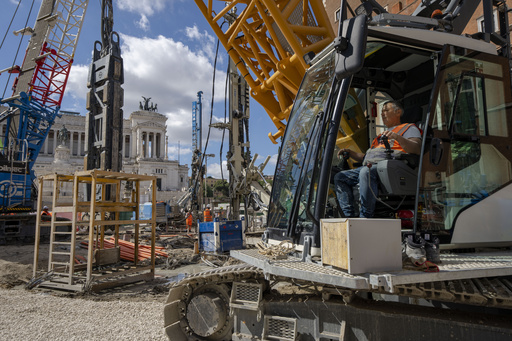
When Pope Francis recently departed the Vatican for his traditional Christmas visit to the city, he revealed an understanding of the discontent that many Romans have been expressing for months. The ambitious plans for a Holy Year have transformed the city into a major construction zone, complete with extensive roadworks disrupting major roads, scaffolding around significant monuments, and an increase in short-term rentals consuming large portions of apartment buildings.
Francis encouraged the people of Rome to pray for their mayor, acknowledging the challenges faced, while also asking them to view the forthcoming Jubilee as a period for spiritual healing and revitalization. He remarked, “These worksites are fine, but beware: Don’t forget the worksites of the soul!”
Next week, with the formal commencement of the Holy Year, Francis will unveil an exciting agenda packed with events over the next year, featuring special Jubilee Masses designed for various groups, including artists, youth, migrants, educators, and prisoners.
While the start of the Jubilee signals an end to the most disruptive construction phases, it also heralds the anticipated arrival of approximately 32 million pilgrims in 2025, which is expected to exacerbate congestion in the city and exacerbate a housing crisis that has already pushed many residents away.
Similar to other renowned European art centers, Rome is grappling with issues of overtourism as the Italian travel industry rebounds from the COVID-19 pandemic. A record 133.6 million individuals visited Italy last year, with foreign tourists contributing notably to the increase reported by national statistics bureau ISTAT, benefiting Italy more than the EU average.
Rome, known for its vast artistic heritage and as home to the Vatican and Italy’s busiest airport, has been identified as the leading city for overnight bookings in registered lodgings, according to ISTAT. However, despite its many attractions, Rome struggles to meet modern urban standards, known for its inadequate public transport and garbage collection systems. The past two summers saw so many challenges with taxi availability that the city government issued 1,000 new taxi licenses for 2025.
The local housing crisis has grown increasingly severe, leading some community members to take matters into their own hands. Vigilantes have been reported using wire cutters to disable keyboxes on short-term apartment rentals, which are believed to contribute to rising rents and displacing local residents.
“The market is out of control and has definitely worsened with the influx of tourists and with the added pressure of the Jubilee,” stated Roberto Viviani, a university researcher facing complications as his landlord opted not to renew his lease to turn the apartment into a holiday rental. “The surprising part was that the Jubilee was given as the reason.”
As the Jubilee is set to kick off on December 24, it is met with mixed feelings by locals. Traditionally, the Holy Year draws pilgrims to Rome every 25 years to visit the graves of Saints Peter and Paul and receive indulgences for their sins. For the city, this represents a chance to utilize around 4 billion euros ($4.3 billion) in public funds for overdue developments aimed at rejuvenating the city, lifting it from years of inertia.
However, for many Romans, particularly in neighborhoods like Pigneto, this initiative poses further threats to the character of their communities and affordability of housing. Alberto Campailla, the director of the association Nonna Roma, noted that the Jubilee has intensified the already concerning impacts, as they protest the rise of tourist rentals by tagging Pigneto keyboxes with messages like “Your BnB, our eviction.”
The history of Jubilees in Rome dates back to 1300, when Pope Boniface VIII initiated the first Holy Year, solidifying Rome’s position as the epicenter of Christianity. The number of pilgrims has historically been significant, drawing mentions in works like Dante’s “Inferno.”
Major public works have typically accompanied these Holy Years, from the construction of the Sistine Chapel for the Jubilee of 1475 to the Vatican garage developed for the Jubilee in 2000 under St. John Paul II. While some projects, like the expansive Via della Concilliazione leading to St. Peter’s Square, faced controversies—resulting in the demolition of entire neighborhoods for the 1950 Jubilee—the upcoming 2025 Jubilee includes plans for an extension of that thoroughfare.
The most ambitious project for the upcoming Jubilee entails a pedestrian plaza along the Tiber, connecting Via della Concilliazione to the nearby Castel St. Angelo, with an underground diversion of the major road currently separating them. While the budget for this project stands at 79.5 million euros ($82.5 million), it faced delays over the discovery of archaeological ruins, but work has resumed, with an opening planned for the eve of the Jubilee.
Mayor Roberto Gualtieri emphasized a renewed focus on parks and green initiatives for the 2025 Jubilee projects, aligning with Pope Francis’s environmental priorities.
Pope Francis has also recognized the paradoxical effects of the Jubilee on Romanians’ daily lives and previously urged local clerics to generously offer any unused real estate or apartments in convents to help those at risk of eviction.
“The goal is for diocesan properties to contribute to alleviating the housing crisis through acts of charity and hope for those living in precarious conditions,” Francis stated.
Gualtieri’s administration has also pushed for national legislation to regulate short-term rentals, which are believed to limit long-term rental availability, consequently inflating prices by around 10% in just a year. “It’s vital for us to stop entire areas of the city from being emptied of residents and converted into B&Bs, as maintaining a resident presence in the city is crucial,” he asserted.
In contrast, Monsignor Rino Fisichella, the Vatican official overseeing the Jubilee, defended the event as integral to Rome, suggesting that the influx of pilgrims ultimately serves as a benefit for the city. “Rome has always been a ‘common home,’ welcoming all. To suggest otherwise would harm its identity,” he expressed at a Jubilee promotional occasion.
